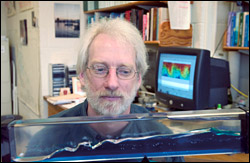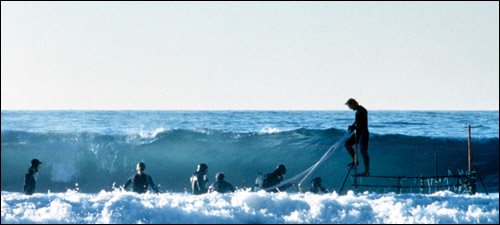
|
 |
Research > Science
Highlights > Doing the Wave
Doing the Wave
 |
 |
Geologist
Associate Scientist Tim Duda demonstrates with a wave
tank what it is difficult to see in the ocean: how differences
in fluid properties can lead to waves beneath the waves.
(Photo by Tom Kelindinst)
|
Surfers and satellites make unlikely oceanographic assistants,
but both are helping investigators from the Applied Ocean Physics
and Engineering Department study the basic physics of ocean
waves on scales varying from centimeters to hundreds of kilometers.
For more than a decade, Associate
Scientist Britt Raubenheimer and Senior Scientist Steve Elgar
have been working together to decipher the patterns and processes
of the shore environment. Most of their work takes place in
the breaking waves of the surf and swash zones, from “where
the water barely covers your feet to where it just covers your
head,” as Elgar says.
Along the U.S. coastline, from Truro,
Massachusetts to Duck, North Carolina, they have fought the
pounding surf to set up current meters, pressure gauges, and
other sensors that measure the movement of currents, waves,
and sand. Their work could help coastal policymakers and managers
understand how the movement of water affects the evolution
of coastlines, the safety of beachgoers, and the dispersal of
runoff and pollutants.
In the fall of 2003, their work took them to Scripps Canyon
near La Jolla, California, for a study of how deep submarine
canyons can produce incredible waves, rip currents, and placid
lulls all within just a few miles of Pacific shoreline. Working
with fellow principal investigator Bob Guza of the Scripps Institution
of Oceanography, Elgar and Raubenheimer led a team of 25 scientists,
divers, and engineers—plus a few surfers and lifeguards
who kept kelp and people off their instruments—in the
Nearshore Canyon Experiment (NCEX).
Offshore
canyons are thought to focus and channel
the energy of ocean waves as they pile up along the continental
margins. But until NCEX, very little real-life data had been
collected to support the theories
and models (most previous work had been done on simpler, smoother
shelves).
 |
| Britt Raubenheimer (second from left), Steve Elgar (fourth from left), and their research team struggle to deploy current- and sediment-observing equipment near La Jolla, California. (Photo by Susan Green, SIO) |
“As waves pass over the canyons,” Raubenheimer
said, “the steep topography can act like a magnifying
glass and concentrate ocean wave energy in hot spots where waves
are large. Alongshore variation of waves and currents can result
in rip currents.”
Working in arduous conditions—“We’ve
never worked where the circulation is so crazy,” Elgar
said—the team collected “a spectacular data set.”
They also showed, in real time, the societal benefits of their
research.
When 130,000 gallons of sewage spilled from a local water system
into the ocean, the NCEX team provided information on how the
contaminants were dispersing along the coast.
In the deeper waters
of the East China and South China seas, Associate Scientist
Tim Duda examines waves up to 100 kilometers long, but so subtle
that they are rarely visible at the surface. Duda studies a
phenomenon called internal waves, which form along the intersection
of waters of different density or temperature
in the interior of the ocean (such as saltier water flowing
beneath fresher water). These waves can pulse through a sea
in cyclic frequencies known as internal tides.
At the extreme,
internal waves can grow
150 meters tall, yet the average boater wouldn’t
notice the passage of an internal wave unless trained to detect
the telltale bands or slicks that sometimes form on the surface. Most often, these huge phantoms
(and the enormous yet diffuse energies they carry) are detected
only by satellites or innovative underwater instruments.
A few
years ago, Duda and more than a dozen WHOI colleagues deployed
temperature-sensing moorings to examine internal waves and tides as part of the
Asian Seas International Acoustics Experiment. Duda and scientists
from China and the United States found the internal waves and
tides of the South China Sea to be much more potent than expected.
The complex seafloor of the region seems unusually efficient
at generating internal waves, so the team is now analyzing its
new data to figure out where those waves are generated and where
their
energy goes.
For Duda, understanding the motions and patterns
of internal waves could help improve our understanding
of how water masses of different densities mix and drive ocean
circulation. Energy is radiated throughout the oceans by internal
waves, which randomly break down and cause mixing. (By comparison,
when atmospheric
internal waves mix, you usually spill your coffee
as your airplane bounces in the turbulence.)
“If we can
demonstrate in a few spots that we can model the tides and waves
correctly,” Duda said, “then we may improve the
fidelity of ocean and climate
models by properly accounting for mixing.” Understanding
internal waves has important implications
for understanding acoustic communication in the ocean, sonar performance, and the biological productivity
of certain regions.
óMike Carlowicz (mcarlowicz@whoi.edu)
|
|
